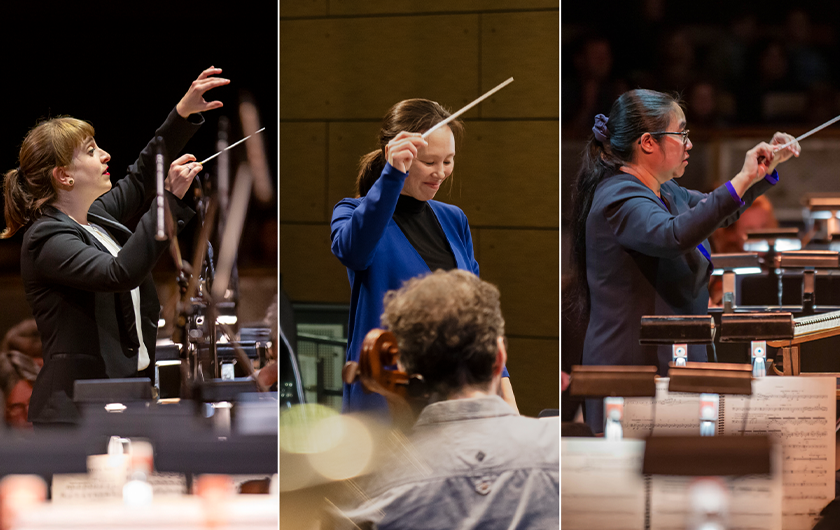Tapestry Opera’s Women in Musical Leadership Program Offers a Foothold for Emerging Women and Non-binary Conductors
BY ELIZABETH CHORNEY-BOOTH

While the world of orchestral music has certainly become increasingly inclusive over the decades with a wider diversity of people in performance and administrative roles, getting up to the conductor’s podium can still be a steep climb for women and non-binary musicians.
Women conductors often fall prey to an experience paradox of sorts: organizations wishing to put established female or non-binary conductors in front of their orchestras often can’t find suitable candidates because not enough women have been given equal chances to gain the necessary experience.
As with any kind of long-standing professional barrier, it’s the kind of vicious cycle that can’t be broken until someone intentionally decides to act as a disruptor. Fortunately, a forward-thinking opera company in Ontario is working to shake up gender equality in Canadian orchestral music by giving underrepresented conductors a leg up. Toronto’s Tapestry Opera has created an initiative to help address Canada’s deficit of women and non-binary conductors. The Women in Musical Leadership (WML) is a three-year program that helps promising conductors to develop their skills, make contacts, and gain the experience necessary to help land jobs with musical organizations across the country and around the world.
Tapestry’s General and Artistic Director Michael Hidetoshi Mori and Executive Director Jaime Martino had long been discussing their desire to work with more women conductors and realized it was up to them to take action.
“After so many years of conversation, Michael and Jamie decided to fix this problem to make sure there are conductors who are women or non-binary people who have the experience companies need to be able to trust them, hire them, and give them the experience they need,” says Camille Rogers, WML’s project manager.
WML works to give its conductors both training and experience with two participants invited each year to begin the three-year program. Tapestry has partnered with over 20 different organizations throughout Canada, which offer the conductors professional placements — with travel and accommodation costs covered — beginning with assistant conducting work, with the opportunity to take on more responsibilities as they progress. WML’s administration matches participants with orchestras and opera companies both big and small, performing a range of repertoires to help them explore which work best suits their talents. They are also matched with opportunities that align with their individualized interests and backgrounds while also receiving support in the form of career coaching and leadership workshops.
The idea is to give each conductor all the real-world training, mentorship, and experience that a budding male conductor may organically receive during the early part of his career. Of course, the timeline is condensed, and the travel may be more frequent, but the participants prove themselves by putting in three years of intense work.
“The conductor basically has a full-time job, similar to what a resident conductor would have if they were employed at one orchestra, except the work they’re doing is spread across Canada,” Rogers says. “They’re doing a lot of assisting, some observing, and taking on some conducting as well, depending on what is available at our different partner organizations.”
Since launching in 2020, WML has brought six conductors into the program including Calgary Philharmonic Resident Conductor Juliane Gallant, who took part in WML’s inaugural cohort.
While the program certainly benefits its participants in a tangible way, there’s a larger goal of benefitting musical organizations across Canada by widening the field of prospective musical leaders. Rogers notes that while there’s not something consistently different about the way women and non-binary conductors approach their work, expanding the diversity of musical leadership in Canada should naturally lead to innovative approaches and more engagement with audiences.
“Our job is not to make them all into the same conductor, but to help them bring their unique conducting approach and leadership style to the highest level,” Rogers says. “They have such different approaches, not just in the physical gestures of how they conduct, but also how they’re interpreting the music and how they’re engaging with the orchestra.”
Audiences at the Calgary Philharmonic have already seen the results of the WML program through Gallant’s work. Originally from New Brunswick, Gallant first found herself working in Calgary when WML secured her a conducting placement for a Calgary Phil Symphony Sundays for Kids concert during the 2022/2023 season. She was hired on as Resident Conductor the next year and has been embraced by Calgary audiences ever since.
Additionally, participants from each subsequent WML cohort have performed with the Calgary Phil, and this season sees Monica Chen, part of the third cohort, return to lead the Orchestra through a performance of The Gruffalo as part of the Symphony Sundays for Kids series. Also in September, Eve Legault, the latest conductor to join the program, is set to conduct The Music of Sting + The Police.
Rogers says Tapestry considered the first five years of the program as a pilot of sorts but the success of conductors like Gallant have provided ample evidence their efforts are working as intended. Going forward the program will reduce the number of new recruits to one per year so there will be three conductors working within WML any given time, but otherwise, Rogers expects the initiative will go on indefinitely.
“We hope the whole industry is becoming more welcoming to everyone, not just to women,” they say. “The ideal would be you wouldn’t even think twice when you see a woman on the podium.”
